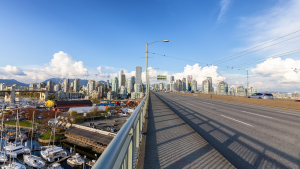Metro Vancouver is embarking on one of its largest projects ever that will transform the Iona Island Wastewater Treatment Plant.
The $9.9 billion multi-year program includes construction of a new tertiary treatment facility and a range of ecological restoration and off-site projects that will improve the connection between infrastructure, the community and the environment.
It’s the largest capital program ever undertaken by Metro Vancouver — a federation of 23 municipalities, one electoral area, and one treaty First Nation.
The current facility, which was commissioned in 1963, is one of the only plats of its kind in North America that only does primary treatment.
“That’s basically just where there is a mechanical treatment process to remove suspended solids,” explained Cheryl Nelms, general manager of project delivery for Metro Vancouver.
Secondary involves adding other processes to remove dissolved solids, which is going to be required by the federal government. The program is taking this a step further to tertiary treatment, which is a more in-depth filtration process.
These upgrades are expected to massively reduce the discharge of total suspended solids and biochemical oxygen demand, cut greenhouse gas emissions and provide a safeguard against a baseline of harmful chemicals in the wastewater effluent stream.
It will also increase safety. Officials say the aging infrastructure is highly vulnerable to both earthquakes and sea level rise. They noted either of these hazards could result in a total loss of wastewater treatment for Vancouver, the University Endowment Lands, and small portions of Richmond and Burnaby for many years.
The size and importance of the program meant it would be guided by Nelms’ department which was created to handle Metro Vancouver’s largest, most complex projects.
“It’s a program of more than $22 billion,” Nelms said. “It’s a massive program. One of the largest in the country.”
Nelms and her team shepherd these projects through a stage gate process.
“There is more and more billion-dollar projects and in the past it used to just be hundreds of millions,” she said. “There are community considerations, regulators, permits. There is an increase in complexity now that goes beyond just a technical solution.”
It will be the first major capital project to use Metro Vancouver’s newly adopted Best Practice Project Cost Estimating Framework at such an early stage. According to project documents, the framework includes a more rigorous approach to addressing challenges inherent in estimating future costs on large, complex and lengthy projects, including using forecast cash flows to estimate escalation as well as the inclusion of a project risk reserve and appropriate contingency amounts.
According to Metro Vancouver, the purpose of the framework is to provide a complete and more realistic estimate of the projects with a greater probability of actual costs at completion being within the original budget estimates.
“We are looking at this as a transformative project,” said Nelms. “The legacy is going to be really improved effluent going into the Salish Sea, a restoration of Iona Island that improves habitat for marine and terrestrial life. What is transformative about this is integrating all the ecological aspects and community interests into the project.”
Part of the process was listening. The team sought design input from an international team of experts as well as from local Indigenous groups like the nearby Musqueam.
Nelms noted the project is also an opportunity for learning and sharing with the region’s universities about the impact and opportunities around water treatment systems.
“A lot of this is hidden infrastructure that nobody is really aware of, but it has a significant impact on our environment,” said Nelms. “Research opportunities and participation from universities is important because we our building a civil sector for our region.”
With the approval of the project definition, efforts will fully transition to the next phases of work.
From 2022 to 2027 there will be a focus on design, early works and ground improvements followed
by the main wastewater treatment infrastructure construction from 2028 to 2035, and final site restoration and projects closeout from 2035 to 2038.
Secondary treatment is anticipated to be operational by mid-2035, which is four-and-a-half-years after the regulatory deadline of Dec. 31, 2030, and final construction is forecast to be complete in 2038.
Follow the author on Twitter @RussellReports.











Recent Comments